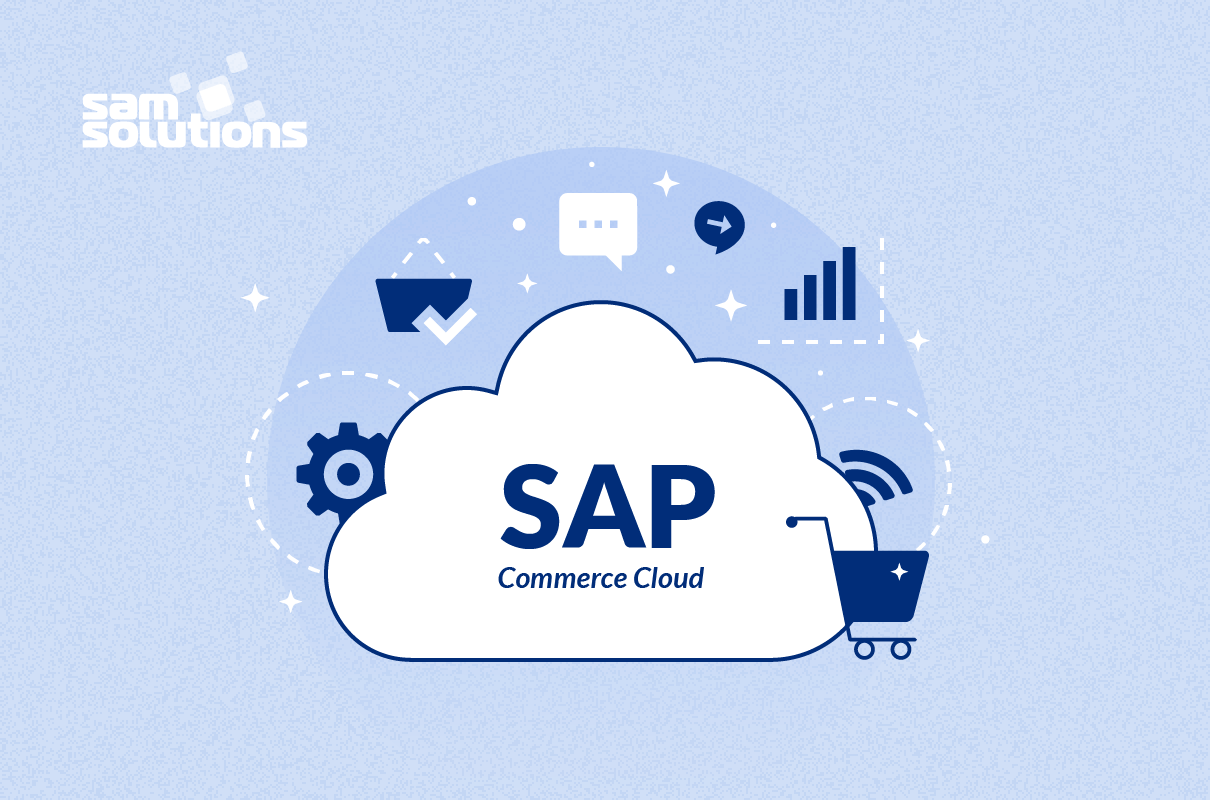These days, customer service in online stores is equally essential as in brick-and-mortar shops. The fact is that incorporating customer service best practices into your ecommerce organization will pay valuable dividends in the form of longer, stronger, and more rewarding relationships with your clients.
In this article, we explain what ecommerce customer service is and what best practices you can use to improve it on your website.
SaM Solutions offers a wide range of platform-based and from-scratch ecommerce development services that help you reach your digital sales objectives.
What Is Ecommerce Customer Service?
In-person shopping is based on the direct communication between a buyer and a seller. This model implies that a buyer always knows who to ask a question, if any arises; while a seller can propose assistance themselves if indirect signs show that a buyer needs help.
The ecommerce industry is based on online shopping, meaning that products and services are offered to buyers over the internet and without personal contact. So when customers have a question or issue with your product or service, they shouldn’t be left one on one with the computer or mobile phone screen. They should have the possibility to instantly contact a company’s representative and get help. This practice is called ecommerce customer service.
Customer service teams of ecommerce businesses should be accessible through all channels that clients use to contact the brand and make purchases, including a live chat on the website, a mobile app, social media profiles, or a call center. The support process should be simple and efficient.
In case online purchasers have difficulties contacting customer service representatives, they are most likely to turn to competitors and never come back to your brand. Here are some stats:
- Ecommerce merchants who do not have good customer support lose an average of 37% of their clients within a year.
- 89% of consumers started doing business with a competitor as a result of a poor customer service experience.
- 60% of ecommerce shoppers are ready to pay more to get a better customer experience.
Remember that a dissatisfied buyer can share their experience with hundreds of people online and cause serious damage to your company’s reputation.
What Are the Benefits of Providing Ecommerce Support Services?
The owners of many ecommerce stores do not even think about the importance of customer service. They consider it sufficient to provide a phone number, an email address, and a checkout form on the page. Unfortunately, this limited view of online sales has a negative impact on their revenue.
The formula is simple: to make money online from selling products and services, no matter what industry you are in, you must have perfect customer service. Maintaining solid relationships with your buyers is essential to growing your ecommerce business. Hence, the quality of your customer service will always determine the number of zeros in your bank account.
Look at some benefits that a well-organized customer service department provides to ecommerce stores.
- Increasing customer loyalty. Maintaining customer loyalty only due to product quality has become impossible nowadays. The client can always find an alternative to your company’s product from competitors. Therefore, it is worth investing no less resources in retaining current clients than in attracting new ones. Customer loyalty and a positive opinion about your brand are created from a positive experience of interacting with the company. In order for a buyer to leave a positive review about a product, ecommerce companies need to build long-term relationships with the client. This can be achieved by improving customer service. Even small customer service mistakes can hurt a company’s reputation, as consumers are more demanding and not afraid to voice their opinion online about their shopping experience.
- Attracting new clients. The quality of customer service in ecommerce affects not only customer retention and repeat sales, but also helps companies attract new clients. Here works word of mouth. When someone is only examining product offerings on the market, clients’ testimonials and reviews play a crucial role. And even if the product is good, but clients complain that the seller ignores customer requests or processes them improperly, new clients will likely find something else. Conversely, an ecommerce store whose clients say that all their issues are resolved literally on the fly is gaining more new clients.
- Getting feedback from clients. Customer service teams communicate with clients on various issues and receive lots of feedback on provided products and services. This way, they extract valuable information for further improvement and development of the ecommerce business. Based on the questions and issues that clients face and address to the customer service representatives, ecommerce companies can change the existing parameters of products or services, as well as add new features and improve their quality. Without a customer service department in place, this information would not reach business owners and many opportunities would be missed.
How Is Ecommerce Customer Service Different from Retail Customer Service?
The main difference between providing customer support in traditional retail stores and ecommerce stores lies in the ability of customer service agents to see the shopping context and act according to it.
Traditionally, there are assistants or consultants on the shop floor who monitor customer behavior, identify customer purposes (whether a person is looking for a particular thing or just window-shopping), and determine their mood by facial expressions and gestures. Based on such information, assistants can select the most appropriate way of providing customer service (whether to offer help or not to disturb clients).
Moreover, in an ordinary store, clients know that they can look around and find a consultant who will help them instantly.
It should be noted that offline stores have also started incorporating digital technologies for delivering customer service. For example, digital signage solutions installed in retail stores bring lots of benefits and improve customer service as well.
In ecommerce stores, customer service assistants are deprived of the ability to see clients, hence they lack much helpful contextual information. What they can do is analyze digital data (personal profile, buying history) and use all possible communication channels to solve issues. So the approach to customer service in ecommerce stores should be different.
8 Ecommerce Customer Service Best Practices
Digital technologies are changing the way clients interact with ecommerce stores. For modern customers, price is not the main criterion for choosing a product or service. They focus on the value of the online experience they get. So ecommerce companies must create personalized, interactive relations that generate interest and emphasize respect for the preferences of each consumer, no matter through what channels they get in touch with the brand.
The following are some best practices you can leverage for your ecommerce business.
1. Offer multichannel support
A client should be able to contact a sales consultant just as easily as in a brick-and-mortar store. Therefore, having one or two communication channels is not enough for a modern ecommerce business. Organizing multichannel support is a must. This way, you provide your clients with more opportunities to request assistance and significantly reduce (or even eliminate) the risks of leaving a client alone with the problem.
Using a multichannel customer service strategy, you bring together all customer touchpoints on a single platform, support them throughout the purchase journey and offer them a consistent experience.
To always keep in touch with your clients, use a variety of channels, including:
- a call center
- SMS
- messengers
- social media
- chatbots
- online chats on the website
- a reliable FAQ section on the website
2. Personalize support and marketing
Modern standards demand from ecommerce stores more personalization that keeps clients coming back. Relevant goods and services offered to each particular client on favorable terms make them more willing to share their needs and preferences with the company.
The future of customer service in ecommerce is also related to personalization. For example, customer service specialists can collect and leverage information such as personal data (gender, age, place of residence), shipping and payment preferences, product viewing history, etc. By analyzing this data, they can tailor support methods for each client, as well as offer relevant products in the future and solve emerging problems faster.
Thanks to personalization technologies, customers have the feeling of being treated like an important part of your business and not just another potential sale on today’s list.
3. Enable self-service
Another effective way to communicate with ecommerce clients is to offer them self-service features. These are tools that clients use to find solutions to their problems without the help of a customer service representative.
When buyers have some questions, they don’t necessarily need to start a formal request. They can check a knowledge base or a FAQ section on your website and find the answers quickly. Take time to prepare a comprehensive knowledge base with the answers to common issues that arise every day, and you’ll save much more time of your clients and customer service specialists.
4. Use the right organizational tools
No matter how big your ecommerce company is, there are specialized customer service tools that can have a significant impact on your business. These tools automate support functions and empower your customer service team.
Among the most popular tools is Service Hub by HubSpot. It’s great for ecommerce businesses for a number of reasons. For example, you can integrate Service Hub with Shopify and engage visitors when they take an action on your website. In addition, Service Hub has free tools for chats and chatbots. You can easily install these features on your ecommerce website to offer your clients immediate help.
5. Offer an avenue for providing feedback
Your current customers may be not happy enough with their ecommerce experience and hence not brand loyal. But the situation is not a catastrophe if you put it on the right track. In fact, dissatisfied clients can provide valuable information that will help improve the interaction of both parties in the future. What sellers must do is to provide clients with convenient feedback opportunities. Ask them to evaluate the order after receiving it, leave a comment on the purchased goods, or take a short survey.
Thus, you can reveal trouble stops in your processes and make an effort to improve them. In addition, your clients will see how valuable their opinion is to your company and will be more likely to maintain loyalty.
6. Use templates
Since many online shoppers contact customer service with the same problems, ecommerce stores can speed up their solving with the help of templates for emails and call centers. But remember that templates should be written in a clear and concise manner, avoiding formal language patterns, otherwise this may complicate the situation even more. Also, do not overuse templates: they are appropriate for standard situations only, but non-standard cases require personalized answers
7. Make your website or app more helpful
Ecommerce websites and mobile applications should turn visitors into customers. To achieve this goal, they should provide a maximum of useful information concerning goods and the purchase process:
- Detailed descriptions
- Realistic photos
- Delivery terms
- Payment options
- Contacts
- Customer reviews
8. Improve your response time
Average response time is the time between a client submitting a support ticket and the first response from a customer service representative. The response time measures how quickly and efficiently an ecommerce company answers requests, and how long clients have to wait before getting help.
No one wants to wait long to solve a problem, so reducing response time can lead to increased customer satisfaction. You can do it with the help of automation tools, specialized software systems for the ecommerce industry, a multichannel customer service approach, and other best practices. If you get prepared for all possible requests of your clients and anticipate their needs, you’ll be able to offer the best solutions or, in general, avoid many issues.
It’s worth noting that speed means nothing if the problem remains unresolved. Therefore, achieving a balance between speed and quality is a key challenge for the ecommerce customer service department.
Why Should You Choose SaM Solutions as Your Ecommerce Customer Service Provider?
SaM Solutions has profound experience in developing ecommerce projects for retailers from various regions. Our skilled teams work with the leading platforms for ecommerce businesses — SAP Commerce Cloud, Sitecore, and Magento. This means you will get top-notch solutions with all the necessary functions tailored to your business requirements, including customer service. Feel free to contact our specialists for discussion.
What Is Ecommerce Customer Service Automation?
There are many software tools for automating customer services in ecommerce. They eliminate the need to perform routine processes manually, allowing the staff to focus on more productive activities that require their attention, skills, and knowledge.
Such tools offer various functions, for example:
- The integration of a live chat or a chatbot into your website
- Multichannel tracking of customer requests and their allocation
- Data analytics and automatic report generation
What Can be Some Customer Service Issues in Ecommerce?
Traditionally, ecommerce shoppers face the following issues:
- Not user-friendly website or mobile app
- Unclear navigation and a confusing checkout process
- No multichannel support
- Long response time
- No possibility to track orders
- A complicated return procedure
These are the key points that ecommerce businesses should not overlook.
How to Choose the Right Customer Service Software for Ecommerce?
- Understand the requirements of your clients based on the specifics of goods or services you sell.
- Select some appropriate software solutions
- Compare the functionality of selected solutions and choose the one that is most suited to your requirements
- Check user reviews
- Make sure that the software is easy to set up and use
Conclusion
The professionalism and responsiveness of the customer service department should be prioritized in ecommerce, because they affect the number of loyal customers and the company’s reputation. Make sure your support team can resolve any issue and answer any question in the friendliest manner and in the shortest possible time. This way you’ll keep the level of customer satisfaction high.



























 5 Reasons Why Your Business Needs a Mobile eCommerce Application
5 Reasons Why Your Business Needs a Mobile eCommerce Application Using Salesforce to Improve Your Sales Pipeline: Five Tips
Using Salesforce to Improve Your Sales Pipeline: Five Tips Cross-Platform Mobile Development: Five Best Frameworks
Cross-Platform Mobile Development: Five Best Frameworks How to Develop Custom Accounting Software
How to Develop Custom Accounting Software 10 Best Web Development Frameworks in 2024
10 Best Web Development Frameworks in 2024













 Top 30 Ecommerce Tools to Elevate Your Business in 2024
Top 30 Ecommerce Tools to Elevate Your Business in 2024 5 Best Tools to Improve Embedded Software Testing
5 Best Tools to Improve Embedded Software Testing Why React and Node.js Are the Top Technologies for Creating High-Performance Web Apps in 2024
Why React and Node.js Are the Top Technologies for Creating High-Performance Web Apps in 2024 10 Best IoT Platforms for 2024
10 Best IoT Platforms for 2024
I like this article, it contains valuable information for all the owners of eCommerce stores. To remain competitive in the modern digital environment, you should use the best practices to provide your buyers with exceptional services. So this blog will be of much help.
The ultimate goal of e-commerce stores to provide consumers with an amazing online experience is to increase sales, build brand loyalty and customer retention. Well-organized customer support leads to fewer issues or complaints and also increased satisfaction.
For me, the most important elements of excellent customer service include responding in a timely manner, responding knowledgeably, and communicating with customers where they are.
Not paying enough attention to e-commerce customer service can turn out to be a mistake of gigantic proportions for the business. The article provides reasonable tips for avoiding significant issues.
It’s true that for the majority of consumers, customer service is key to their brand loyalty, and a staggering percentage of consumers are more likely to make another purchase after a positive customer service experience.